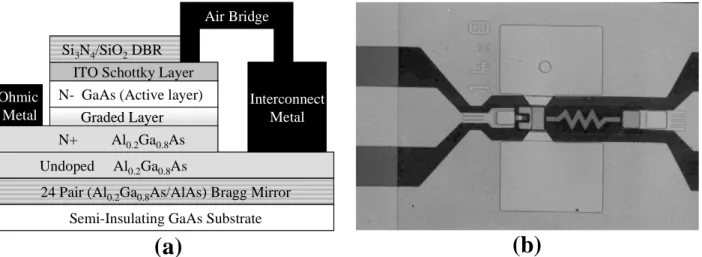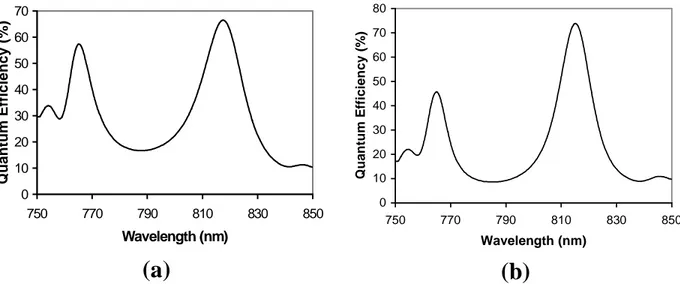45 GHz bandwidth-efficiency resonant cavity enhanced
ITO-Schottky Photodiodes
Necmi Biyikli, Ibrahim Kimukin, Orhan Aytur, and Ekmel Ozbay Department of Physics, Bilkent University, Bilkent, Ankara 06533 TURKEY
biyikli@fen.bilkent.edu.tr
Mutlu Gokkavas and M. Selim Unlu
Department of Electrical and Computer Engineering, Boston University, Boston, MA 02215
mutlu@bu.edu
Abstract: We demonstrated high-performance resonant cavity enhanced ITO-Schottky
photodiodes. We achieved a peak efficiency of 75% around 820 nm with a 3-dB bandwidth of 60 GHz resulting in a bandwidth-efficiency product of 45 GHz.
2000 Optical Society of America
OCIS codes: (040.5160) Photodetectors, (320.7080) Ultrafast devices
High-performance optical communication and measurement systems require photodetectors with high bandwidth-efficiency (BWE) products [1]. The BWE product of conventional photodiodes (PD) is limited due to the bandwidth-efficiency trade-off. Resonant cavity enhanced (RCE) photodetection scheme offers the possibility to overcome this limitation [2]. High BWE products were already achieved using Schottky, p-i-n and avalanche type of RCE-PDs, which could not be reached with conventional detector structures [3-8]. Theoretical simulations predict even better performances for RCE Schottky photodiodes if the optical losses and scattering caused by the Schottky metal - which also serves as the top mirror of the resonant cavity – could be avoided. Indium-tin-oxide (ITO) which is known to be a transparent conductor is a potential alternative to thin semi-transparent Au as the Schottky-contact material [9,10]. Recently we have demonstrated RCE ITO-Schottky PDs with 20 GHz BWE at 840 nm [11]. In this paper, we report our work on high-performance AlAs/GaAs-based RCE ITO-Schottky PDs operating around 820 nm with 45 GHz BWE product.
Semi-Insulating GaAs Substrate 24 Pair (Al0.2Ga0.8As/AlAs) Bragg Mirror Undoped Al0.2Ga0.8As
N+ Al0.2Ga0.8As Graded Layer N- GaAs (Active layer)
ITO Schottky Layer Si3N4/SiO2DBR Ohmic Metal Interconnect Metal Air Bridge
Semi-Insulating GaAs Substrate 24 Pair (Al0.2Ga0.8As/AlAs) Bragg Mirror Undoped Al0.2Ga0.8As
N+ Al0.2Ga0.8As Graded Layer N- GaAs (Active layer)
ITO Schottky Layer Si3N4/SiO2DBR Ohmic Metal Interconnect Metal Air Bridge
(a)
(b)
Fig. 1. (a) Cross section of a fabricated RCE ITO-Schottky PD. (b) Photograph of a high-speed RCE ITO-Schottky PD.
Figure 1(a) shows the epitaxial layer structure of a fabricated RCE ITO-Schottky PD with a dielectric top Bragg mirror. The resonant cavity was formed by a MBE-grown Al0.2Ga0.8As/AlAs distributed Bragg reflector (DBR)
bottom mirror and a PECVD-grown Si3N4/SiO2 DBR top mirror, both centered at 820 nm. The samples were
fabricated by a 8-step microwave-compatible fabrication process. Fabrication started with the formation of ohmic contacts to n+ layers. Mesa isolation was followed by a Ti-Au interconnect metalization. Then, we deposited a 100 nm thick ITO film that acted as the Schottky layer, and a 150 nm thick Si3N4 passivation layer. Finally, to reduce the
WQ51
parasitic capacitance and improve the high-frequency characteristics of the detector, a thick Ti-Au layer was evaporated to form an air-bridge connection between the interconnect metal and the ITO Schottky layer. Figure 1(b) shows a microphotograph of a completed small-area, high-speed RCE ITO-Schottky PD. The resulting RCE Schottky PDs had breakdown voltages around 6-7 V and typical dark current values of 0.1 nA at –1 V bias for a 5x5µm2 device.
The ITO deposition was achieved by RF magnetron sputtering in an Ar environment from a composite target containing by weight 90% In2O3 and 10% SnO2. We have measured the thin-film characteristics of ITO before the
device fabrication. The resistivity of our ITO films were measured to be around 2x10-4Ω-cm. This value decreased to 1.5x10-4 and 1.2x10-4Ω-cm when the films were annealed at 300 oC and 400 oC, respectively. Using a fiber optic based optical transmission measurement set up, we measured the transmittivity of a 150 nm-thick ITO film. The transmittivity was around 87% at 820 nm, and did not change significantly with annealing. Reflectivity at the same wavelength was measured as ~12% which indicated that the absorption in ITO was almost negligible. Ellipsometry measurements showed that the as-grown ITO film had a refractive index of 1.99. This value decreased to 1.85 for an annealing temperature of 450 oC. These results clearly convinced us that the sputtered ITO films should be able to make low-loss, high-quality Schottky contacts to our devices.
0 10 20 30 40 50 60 70 750 770 790 810 830 850 Wavelength (nm) Quantum Efficiency (%)
(a)
0 10 20 30 40 50 60 70 80 750 770 790 810 830 850 Wavelength (nm) Qu an tu m E ffi ci en cy (%)(b)
Fig. 2. Spectral quantum efficiency of the RCE ITO-Schottky PD (a) without top DBR, (b) with 2 pair top DBR
Photoresponse of the fabricated devices were measured in the 750-850 nm spectral range by using a set-up consisting of a tungsten-halogen projection lamp as the source, single-pass monochromator, multi-mode fiber, lightwave probe, probe station and a lock-in amplifier. Figure 2(a) shows the spectral quantum efficiency measurement under zero bias of the RCE-PD without top Bragg mirror. The measured spectral photoresponse of the same device with 2 pair Si3N4/SiO2 top DBR is shown in Figure 2(b). The deposition of top DBR has increased the
peak efficiency from 66% to 75% at 815 nm.
High-speed measurements were implemented by utilizing a picosecond (full-width-at-half-maximum (FWHM) is 1.3 psec) mode-locked Ti-sapphire laser tuned at the resonant wavelength of our detectors. The devices were illuminated using a single-mode fiber on a microwave probe station and the resulting pulses were observed on a 50 GHz sampling scope. The pulse response of the detector was observed to be bias-dependent. While 12 psec FWHM was measured at zero bias, this value decreased to 11.5 psec for 2 V reverse bias voltage. The best measured FWHM was 11.2 psec under a reverse bias of 4 V. Further increasing of the bias voltage made the PD response slower, mainly due to the avalanche gain mechanism which was significant for bias values higher than 5 V. Figure 3(a) shows the measured temporal response of a small area (5x5µm2) RCE ITO-Schottky PD under 4 V reverse bias. The Fourier transform of the temporal data has a 3-dB bandwidth of 43 GHz. The measured data was corrected by deconvolving the scope response. Considering a 9 psec FWHM for the 50 GHz scope, our detectors had a 3-dB bandwidth of 60 GHz. Figure 3(b) shows the as-measured and corrected frequency responses obtained by taking the fast Fourier transform (FFT) of the temporal detector response. The efficiency and bandwidth measurements of the fabricated RCE ITO-Schottky PDs result in a detector performance of 45 GHz BWE product.
WQ52
In summary, we have demonstrated high-speed, high-efficiency RCE Schottky PDs using transparent ITO Schottky contact material and dielectric top Bragg mirror. The peak efficiency and 3-dB bandwidth values obtained from these detectors combine for a BWE product of 0.75x60 GHz = 45 GHz. To the best of our knowledge, this is the highest detector performance reported to date for vertically illuminated Schottky PDs.
This work is supported by Turkish Department of Defense Grant No. KOBRA-001, NATO Grant No. SfP971970, and National Science Foundation Grant No. INT-9906220.
(a)
(b)
Fig. 3. (a)Pulse response of a 5x5 µm2 ITO-RCE Schottky photodiode. (b)FFT of the detector, as-measured (dashed line) and corrected by assuming a Gaussian pulse for the scope response (solid line).
1. E. Bowers and Y. G. Wey, “Handbook of Optics”, McGraw-Hill, 1995.
2. M. S. Unlu and S. Strite, "Resonant cavity enhanced (RCE) photonic devices," J. Appl. Phys. Rev., vol 78, 607-639 (1995). 3. C. C. Barron, C. J. Mahon, B. J. Thibeault, G. Wang, W. Jiang, L. A. Coldren, and J. E. Bowers, “Resonant-cavity-enhanced pin
photodetector with 17 GHz bandwidth-efficiency product,” Electron. Lett. 30, 1796-1797 (1994).
4. M. S. Unlu, M. Gokkavas, B. M. Onat, E. Ata, E. Ozbay, R. P. Mirin, K. J. Knopp, K. A. Bertness, and D. H. Christensen, "High bandwidth-efficiency resonant cavity enhanced Schottky photodiodes for 800-850 nm wavelength operation," Appl. Phys. Lett., volume 72, 2727-2729 (1998).
5. H. Nie, K.A. Anselm, C. Lennox, P. Yuan, C. Hu, G. Kinsey, B.G. Streetman, and J.C. Campbell, "Resonant-cavity separate absorption, charge, and multiplication avalanche photodiodes with high speed and high gain-bandwidth product," IEEE Photon. Tech. Lett. 10, 409-411 (1998)
6. B. Onat, M. Gokkavas, E. Ozbay, E.P. Ata, E. Towe, and M.S. Unlu, “ 100 GHz resonant cavity enhanced Schottky photodiodes,” Photonics Technology Letters., vol. 10, 707-709 (1998).
7. C. Lennox, H. Nie, P. Yuan, G. Kinsley, A. L. Holmes, Jr., B.G. Streetman, and J.C. Campbell, "Resonant-cavity InGaAs-InAlAs avalanche photodiodes with gain-bandwidth product of 290 GHz," IEEE Photonics Technol. Lett. Vol. 11, 1162-1164 (1999).
8. E. Ozbay, N. Biyikli, I. Kimukin, O. Aytur, M. Gokkavas, G. Ulu, M. S. Unlu, R. P. Mirin, and D. H. Christensen, "High-speed >90% quantum efficiency p-i-n photodiodes with a resonance wavelength adjustable in the 795-835 nm range," Appl. Phys. Lett., volume 74, 1072-1074 (1999).
9. D. G. Parker, P. G. Say, A. M. Hansom, and W. Sibbet, "110 GHz high-efficiency photodiodes fabricated from indium tin oxide/GaAs," Electron. Lett., vol. 23, 527-528 (1987)
10. W. A. Wohlmuth, J. W. Seo, P. Fay, C. Caneau, and I. Adesida, "A high-speed ITO-InAlAs-InGaAs Schottky-barrier photodetector ," IEEE Photon. Technol. Lett., vol. 9, 1388-1390 (1997)
11. N. Biyikli, I. Kimukin, O. Aytur, E. Ozbay, M. Gokkavas, and M. S. Unlu, “High-speed transparent indium-tin-oxide based resonant cavity Schottky photodiode with Si3N4/SiO2 top Bragg mirror,” presented at the Conference on Lasers and Electro-Optics (CLEO), 2000 Annual
Meeting, San Francisco (2000)

